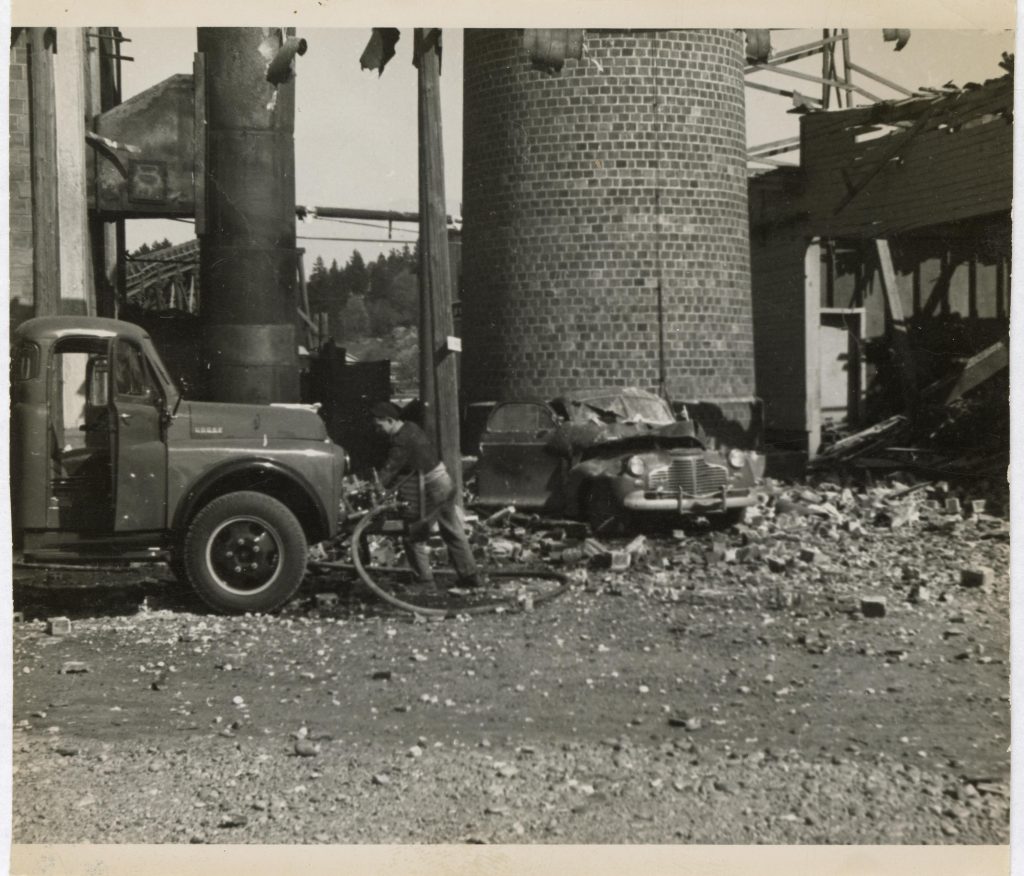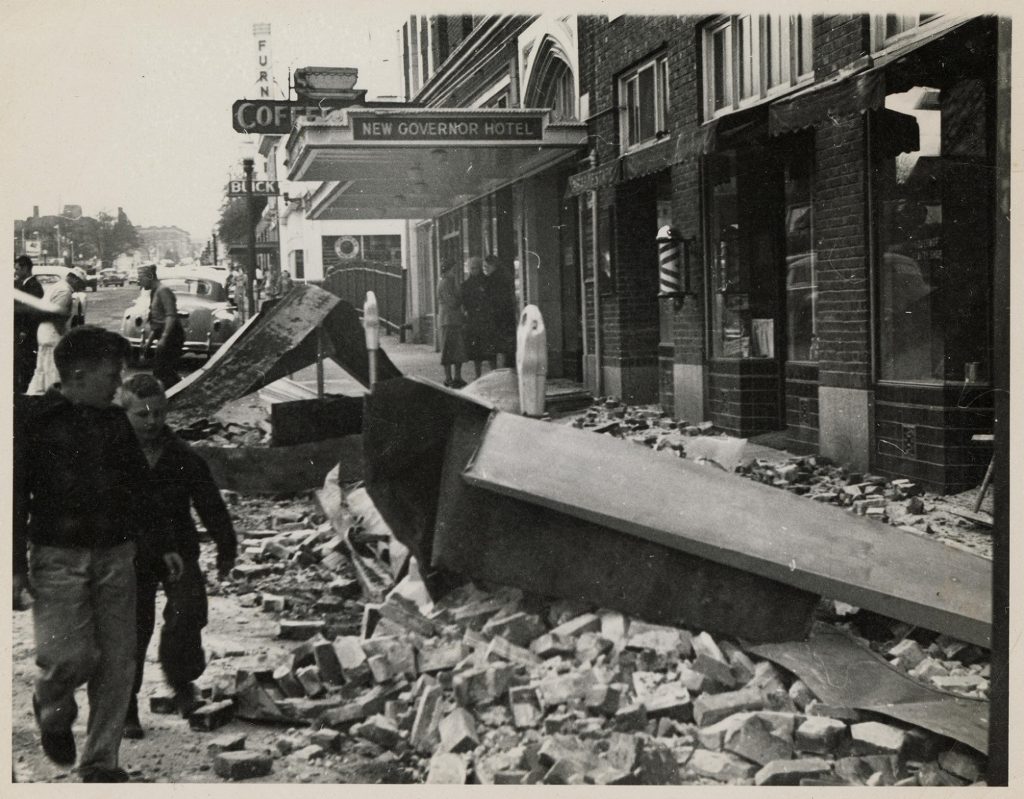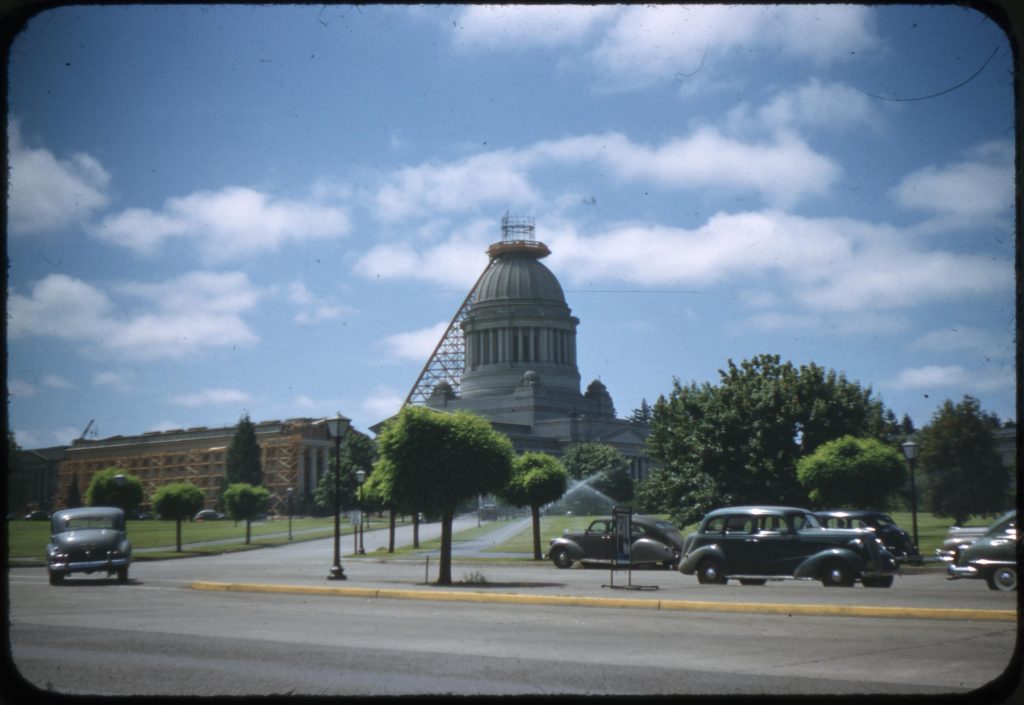In 1949 a 7.1 magnitude earthquake struck Olympia, the strongest quake to hit Puget Sound in recorded history. Named the Olympia Earthquake because its epicenter was between Olympia and Tacoma, the natural disaster caused great damage. This led the Daily Olympian to conclude, “that [this] short, grinding rhumba by Mother Earth did more than any other single event to change the appearance of Olympia.”
April 13, 1949: Olympia Earthquake
At 11:55 a.m. Wednesday, April 13, 1949 the accelerograph in the State Highways Department materials laboratory at State Avenue on Adams Street began scribbling furiously. From his window in the Newhouse Building on the State Capitol Campus, Harold Van Eaton watched masonry fall from the nearby Insurance Building. “It looked like the last days of Pompeii,” he later recalled, “Then I looked over at the Capitol and saw the keystones of the cupola falling out and I thought we were winding up with the Day of Judgment.”
In the cupola, a group of Cub Scouts huddled with their leader, who told them to hope and pray as they waited for the shaking to stop. “What,” exclaimed Gerry Hilden, “do you think I’m doing?”
Olympia Earthquake Leaves Two Dead
“The ground just won’t stand still!” proclaimed the daughter of Leo Steere. When the ground finally did stand still about 30 seconds later, it was time to assess the damage. The shaking created an island in Moss Lake near Stevens Field and sunk a sand spit at the end of Cooper Point. 75 feet of Black Lake Boulevard fell into the lake a half mile north of Columbus Park. Oyster workers at Mud and Oysters Bays described the sand as bubbling and splashing like a “very heavy soup that is being carried in a big bowl by a tipsy waiter.”
Locally two people lost their lives in the quake. Percival Bisson, a steamfitter, was crushed by falling bricks at the Washington Veneer Company plant at the Port of Olympia. Lillian West succumbed to a heart attack in her home at the Governor Hotel.

Olympia Recovers from Earthquake Damage
Work for many resumed almost immediately. The Olympia Brewing Company, for example, shut down the bottling line when the ground started to shake but had it back humming about two minutes later.
Still the quake did great damage to Olympia’s downtown, causing windows to break and bricks and masonry to fall from buildings. Many homes lost chimneys. Major-General Harry Collins, commander of Fort Lewis offered aid and the Red Cross set up cots for hotel evacuees but neither proved necessary.
There were only a few disruptions to power and telephone service. Olympia operators were so overwhelmed with calls that they had to bring in more workers. Water mains broke and the water level at a small earthen dam at McAllister Springs sank.
Schools closed on the day of the quake and reopened the next day. McKinley School’s damaged chimney was replaced the same night. Rochester High School lost half its brick veneer.

At the Tumwater School, a janitor narrowly pushed a child out of the way of a falling cement slab while at Lincoln first grader Helen Powell was hit in the head by falling roof tile on her way home for lunch. Olympia High School closed again Thursday morning after a growing crack was discovered in its smokestack. Their unoccupied auditorium was also damaged by falling plaster.
People tried to get things back to normal as quickly as possible. The Olympia News published its next issue in an office covered by broken plaster and scattered type. The Capitol Theater started playing “I Remember Mama” and “Bambi” the night of the quake as scheduled while the Olympia Library reopened Thursday despite books being toppled.
Churches opened for worship in their buildings on Easter that Sunday, except for First Methodist which had to relocate services to the Olympic Theater.
Olympia Rebuilds After 1949 Earthquake

City inspectors roped off 11 buildings on the day of the quake, and more damage was discovered in the days ahead. Some of these buildings were torn down such as the Kneeland Hotel, which had been built in 1889 and Capitol Savings and Loan. Other historic buildings lost decorative exterior stonework.
All this repair work proved difficult and costly. New brick supplies were depleted, prompting the Olympia Building Trades Council to urge residents to make use of undamaged fallen bricks. Repairs and rebuilding efforts would last years.
First Anniversary of the Olympia Earthquake
On the first anniversary of the earthquake, the Olympian celebrated the ongoing recovery. It could have been much worse. If the quake had lasted longer many buildings could have collapsed or if it had struck even minutes later while people had been out to lunch, the death toll might have been higher. Although unfortunate, it proved a reason to construct new and better buildings.
Since then, people have worked hard to make Olympia buildings more seismically sound, a lesson reinforced by quakes in 1965 and 2001. The 1949 natural disaster left a lasting memory in the region. “Boys and girls now in school,” observed the Daily Olympian in May 1950, “will be telling their grandchildren about those two minutes way back in ’49.”














































